


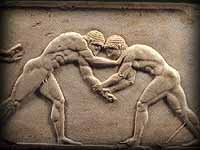

Temples or sewers?






Temples or sewers?

Temples or sewers?
1-23-2008
Early in January, while I was working on AGOGE Reply III: The Longing for Masculinity, and which I'm going to keep pitching to you guys because it's important -- for YOU -- that you read it --
I came across an article on the Washington Post titled A Young Man Learns to 'Embrace' His HIV Status.
It's not a very interesting article.
It's just another first-person account from yet another feckless gay-identified teenager of getting infected -- except that of the how, who, where, why, and when, it just so happens, he's utterly clueless -- and, like our dear Mr Andriote, he doesn't think it matters --
but -- he's learning "to live with it."
Or, as the article says, "embrace it."
Isn't that sweet?
Wouldn't you like to give that big ole virus a big ole gaiboi hug?
Okay, like I say, the article was not very interesting.
However, attached to it, via this link and that, was a sort of bloggish featurette called "Living HIV Quilt" -- and isn't that original? -- Tell Us Your Stories.
With the following blurb:
Tell Us Your Stories
What is the story of AIDS in the District of Columbia? In the 25th year of the epidemic, treatment has improved, but the issues of social isolation and, often, economic instability remain. These 25 residents and AIDS workers shared their lives. Now share yours.
Now, I have to admit that I didn't read all twenty-five accounts.
To be honest, I couldn't figure out where they are -- or if they're there at all.
What interested me was the invitation to "share your story."
In my naive way, you see, I thought I might be able to get in a good word for Frot.
No such luck.
It was an old blog, it turned out, dating from World AIDS Day 2006, and no new posts were being accepted.
Nevertheless, what grabbed my attention was the very first comment posted in the blog, from a guy calling himself "bigolpoofter."
Bigolpoofter claimed that he'd been infected for 23 years, that he was living with the virus successfully -- and he urged people to get involved in helpful, motherhood-and-apple-pie sorts of ways, like volunteering or taking part in a vaccine trial.
But then he ended his post with these words:
"And, brothers, treat your bodies as temples, not sewers!"
As you can imagine, that comment was not well received.
The very next post took bigolpoofter to task:
I think that is a huge mis-statement. World AIDS Day is about bringing awareness to prevent future infections, but also about bringing the people we have casted out back into our community and into our families. Not everyone contracts the disease the same way, thus ignorance is our first battle. Rather then behaving ourselves, lets educate ourselves to change the future. Comments like that (directed and pointed) "you" statements that are judging will not change the world.
So right off the bat bigolpoofter was accused, despite his 23 years of living with HIV, of "judging" and, a sin of the first order, making "you" statements --
and, worst of all of course, suggesting that we "behave ourselves."
And so it went.
The next comment accused him of criticizing and isolating:
Okay, tell that to Ryan White who was born with AIDS. Also, that type of attitude is not helpful. This is everyone's responsibility, to support and join together, not to critize and isolate.
By the way, and for the record, Ryan White was NOT born with AIDS.
He was a hemophiliac who got the disease through a tainted blood product.
But, you know, in the mythology of AIDS, it works better if the poor kid was born with the disease.
Then we don't have to address the people whose behavior tainted the blood supply in the first place.
Now, of course, not all the posted comments were in response to bigolpoofter, but the consensus was there that we must never make "you statements," must never criticize, must never seek to ascribe blame, and must never never never address the actual behaviors which lead to infection.
Can't be done.
That would be blaming the victim -- homophobia -- and shaming gay sex -- erotophobia.
But of course that's nothing new -- we've known for years that anyone who seeks to ascribe responsibility to anyone in the gay male community for anything is blaming the victim and shaming gay sex.
So there's nothing new there.
EXCEPT that exactly ONE week after I'd read the HIV blog in the Post, and read bigolpoofter's plea -- "And, brothers, treat your bodies as temples, not sewers!" -- the MRSA-in-gay-men-story broke nationally, and everywhere, from the NY Times to Fox News to the SF Chron.
Now, if you haven't read these stories, you owe it to yourself to do so, and to do so now, because MRSA is a highly infectious and very dangerous bacterium which is spreading among gay-identified and -- I would suspect -- other "men who have sex with men" -- very quickly.
Here are links to the stories in both the SF Chronicle and the NY Times.
Both articles are good, and they're different enough that it's worth your while to read both.
Here's some of the Chron:
S.F. gay community an epicenter for new strain of virulent staph
Sabin Russell, Chronicle Medical Writer
Monday, January 14, 2008
(01-14) 14:11 PST SAN FRANCISCO -- A new variety of staph bacteria, highly resistant to antibiotics and possibly transmitted by sexual contact, is spreading among gay men in San Francisco, Boston, New York and Los Angeles, researchers reported Monday.
The study released online by the journal Annals of Internal Medicine found the highest concentrations of infection by the drug-resistant bug in and around San Francisco's Castro district and among patients who visit health clinics that treat HIV infections in gay men in San Francisco and Boston.
The culprit is a form of MRSA, or methicillin-resistant Staphylococcus aureus, a bug that was once confined to hospitalized patients but, since the late 1990s, has been circulating outside medical settings, afflicting anyone from injection-drug users to elementary school students. A strain called USA300 has been a leading cause of MRSA infection in this decade, and an exceptionally drug-resistant variant of it is now on the loose, researchers say.
The study estimated that 1 in 588 residents living within the Castro neighborhood 94114 ZIP code area is infected with that variant, which is resistant to six types of commonly used antibiotics. The risk of contracting this difficult-to-treat bug is 13 times greater for gay men than for the rest of the city's population, researchers found.
...
The germ typically causes boils and other skin and soft-tissue infections and, despite its resistance to some drugs, is still treatable by surgical drainage and several classes of antibiotics. What is unusual in this case is the high percentage of infections - up to 40 percent - occurring in the buttocks and genitalia.
Although researchers have stopped short of declaring this form of staph a sexually transmitted disease, the infections are found where skin-to-skin contact occurs during sexual activity.
Most of the infections are limited to the skin surface, but the bacteria can invade deeper tissues or disseminate through the bloodstream. According to the federal Centers for Disease Control and Prevention, various forms of MRSA are causing 95,000 of these more costly and potentially life-threatening infections - and 19,000 deaths - annually in the United States.
Until last year, staph infections had never been linked to sexual activity. Early last year, New York City physicians traced three instances of staph infection apparently spread by sexual contact. Their report was published in February in the journal Clinical Infectious Diseases.
...
Just why the new, more drug-resistant variety is concentrated among gay men is not yet known. Patients infected with HIV appear to run a higher risk of infection, but the study suggests that gay men are being infected with the staph germ regardless of whether they are HIV-positive.
One factor that could be in play is a medical history of heavy use of antibiotics, which creates conditions for breeding drug-resistant strains. Any patient, HIV-positive or not, who has had high previous exposure to antibiotics might be more susceptible.
The good news is that, once the public is aware of the risk, there are ways to prevent the spread of drug-resistant staph. It can be as simple as soap and water.
"Taking a shower after sexual contact may minimize contamination," said Dr. Chip Chambers, director of infectious diseases at San Francisco General, a co-author of the study. "Ordinary soap will do. It dilutes the concentration of bacteria. You don't need antibacterial soap."
Chambers stressed that some people, no matter how fastidious, could be more prone than others to staph infections. They could have unknown genetic traits or a history of antibiotic use that raises the risk.
...
And here's the NY Times:
New Bacteria Strain Is Striking Gay Men
By LAWRENCE K. ALTMAN
Published: January 15, 2008
A new, highly drug-resistant strain of the "flesh-eating" MRSA bacteria is being spread among gay men in San Francisco and Boston, researchers reported on Monday.
In a study published online by the journal Annals of Internal Medicine, the bacteria seemed to be spread most easily through anal intercourse but also through casual skin-to-skin contact and touching contaminated surfaces.
The authors warned that unless microbiology laboratories were able to identify the strain and doctors prescribed the proper antibiotic therapy, the infection could soon spread among other groups and become a wider threat.
The new strain seems to have "spread rapidly" in gay populations in San Francisco and Boston, the researchers wrote, and "has the potential for rapid, nationwide dissemination" among gay men.
The study was based on a review of medical records from outpatient clinics in San Francisco and Boston and nine medical centers in San Francisco.
The Castro district in San Francisco has the highest number of gay residents in the country, according to the University of California, San Francisco. One in 588 residents is infected with the new multidrug-resistant MRSA strain, the study found. That compares with 1 in 3,800 people in San Francisco, according to statistical analyses based on ZIP codes.
A separate part of the study found that gay men in San Francisco were about 13 times more likely to be infected than other people in the city.
...
[emphases mine]
Want to know more?
Here's the
Times Health Guide to MRSA Infection:
Staphylococcus aureus ("staph") are common bacteria that normally live on the skin. The bacteria also live harmlessly in the nasal passages of roughly 30% of the U.S. population. Staph can cause infection when they enter the skin through a cut or sore. Infection can also occur when the bacteria move inside of the body through a catheter or breathing tube. The infection can be minor and local (for example, a pimple), or more serious.
Most staph infections occur in people with weak immune systems, usually patients in hospitals and long-term care facilities. MRSA infections in hospitalized patients are known as healthcare-associated MRSA (HA-MRSA). People who have been hospitalized or had surgery within the past year are at high risk for HA-MRSA. People receiving certain treatments, such as dialysis, are also at high risk. MRSA bacteria account for a large percentage of hospital-acquired staph infections.
Over the past several years, MRSA infections in people not considered high-risk have increased. These infections, known as community-associated MRSA (CA-MRSA), occur in otherwise healthy people who have no history of hospitalization in the last year. Many such infections have occurred among athletes who share equipment or personal items (such as towels or razors) and children in daycare facilities.
And here's the study itself:
Emergence of Multidrug-Resistant, Community-Associated, Methicillin-Resistant Staphylococcus aureus Clone USA300 in Men Who Have Sex with Men. Annals of Internal Medicine, 19 February 2008, Volume 148 Issue 4.
Results: The overall incidence of multidrug-resistant USA300 infection in San Francisco was 26 cases per 100 000 persons (95% CI, 16 to 36 cases per 100 000 persons); the incidence was higher in 8 contiguous ZIP codes with a higher proportion of male same-sex couples. Male-male sex was a risk factor for multidrug-resistant USA300 infection (relative risk, 13.2 [CI, 1.7 to 101.6]; P < 0.001) independent of past MRSA infection (relative risk, 2.1 [CI, 1.2 to 3.7]; P = 0.007) or clindamycin use (relative risk, 2.1 [1.2 to 3.6]; P = 0.007). The risk seemed to be independent of HIV infection. In San Francisco, multidrug-resistant USA300 manifested most often as infection of the buttocks, genitals, or perineum. In Boston, multidrug-resistant USA300 was recovered exclusively from men who have sex with men.
So what have we got?
Well, unlike HIV, which is a difficult pathogen to acquire, MRSA is easy.
It can live not only on the surface of the skin, but on inanimate objects.
Nor is it primarily sexually transmitted, though the warning is that this or another strain of MRSA might become so.
That said, it still isn't clear to me why some people get the infection and others don't.
For example, the Times said:
the bacteria seemed to be spread most easily through anal intercourse but also through casual skin-to-skin contact and touching contaminated surfaces.
"touching contaminated surfaces" has often been cited in other news stories about MRSA.
But as to this -- "the bacteria seemed to be spread most easily through anal intercourse" -- while I'm no friend to anal so-called intercourse, the link isn't clear.
The study was done using records from STD clinics.
Since virtually all MSM STD are anally-transmitted, it's a safe bet that the vast majority of men in those clinics had been doing anal.
Many for example had requested anal pap smears -- to look for anal cancer.
But no one's saying -- at least not yet -- that MRSA lives in semen or can be found in rectal secretions.
Also, sounds as though the sores that were found were external.
The Chron:
What is unusual in this case is the high percentage of infections - up to 40 percent - occurring in the buttocks and genitalia.
Fine.
But the Chron also says:
the bacteria can invade deeper tissues or disseminate through the bloodstream.
Had that happened with any of the gay-identified men?
Since the anal mucosa is so easily torn -- if top A had MRSA on his dick and penetrated bottom B -- couldn't the MRSA get into the bottom's bloodstream?
If it did, washing with soap and water after "sex" -- wouldn't be much help.
Then there's the bit about people who've undergone a lot of antibiotic therapy.
In the early days of AIDS, before HIV had been identified, one theory making the rounds was that guys who'd had a lot of STD and a lot of treatment for STD, had weakened their immune systems or in some other way made themselves vulnerable.
For example, there was some interest in the immuno-suppressive qualities of semen, and what might be happening to people whose rectums -- and bloodstreams -- were constantly hit with those agents.
Once HIV was discovered, no one bothered to look further at ideas like that -- all the action was concentrated on finding therapies for HIV.
But -- maybe being exposed to lots of STD and lots of antibiotics -- isn't such a great idea after all.
In addition, the study said that you didn't have to be immune-suppressed due to HIV infection -- in order to come down with MRSA.
However, the study was looking at records from STD clinics in heavily gay areas.
Where HIV infection is very high.
For example, according to the Bay Area Reporter, a San Francisco gay newspaper -- where, as it happens, my late lover Brett Averill was editor from April to December of 1989 --
Willi McFarland, director of HIV/AIDS Statistics and Epidemiology at the San Francisco Department of Public Health, estimated that 32% of black MSM in San Francisco have HIV, compared with 26% of white MSM, 23% of Hispanic MSM and 10% of Asian/Pacific Islander MSM.
"26% of white MSM" have HIV.
Most gay men in San Francisco are white.
So most likely, and based on other studies I've seen, HIV prevalence among gay-identified men in SF is at 25%.
That's high.
To put it mildly.
And, like I said, the MRSA study was looking at data from STD clinics -- including data from men who'd requested anal pap smears.
Which suggests that a fair number of the guys who'd become infected with MRSA -- were immune-suppressed due to infection with HIV.
But not all of them.
Those, to me, are further questions.
But -- whatever else may be going on, what we can see is a pathogen moving rapidly through a highly promiscuous community.
A community of gay-identified males.
And while MRSA may be new, STD in that community sure isn't.
Since 1975 -- that is to say, since anal and analism became the dominant paradigm in that community -- we've seen many outbreaks of sexually transmitted disease race through the gay male community.
And every gay male knows that.
Because the gay male community is one in which the members, as bigolpoofter would have it, treat their bodies like sewers -- not temples.
And every gay male knows that too.
Nonetheless, what was the reaction in the gay male community to the MRSA story?
Was the community thankful that a group of researchers had followed the outbreak and had warned the community -- about this dangerous pathogen which had the potential to endanger their lives?
NO!
Instead, the community saw in the research a homophobic plot designed to blame the victims and shame gay sex:
After Linking New Strain of Staph to Gay Men, University Scrambles to Clarify
In the Castro neighborhood of San Francisco, some concerns.
By JESSE McKINLEY
Published: January 20, 2008
SAN FRANCISCO -- In a matter of days, it jumped from a routine press release to a medical controversy.
On Monday, a team of researchers led by doctors from the University of California at San Francisco announced that gay men were "many times more likely than others" to acquire a new strain of drug-resistant staphylococcus, a nasty, fast-spreading and potential lethal bacteria known as MRSA USA300. And sure enough, the study, published online in the Annals of Internal Medicine, was quickly picked up by reporters round the world and across the Internet, including a London tabloid which dubbed the disease "the new H.I.V."
But for gay men in the Castro neighborhood here, which was an early epicenter for the AIDS epidemic and a current hot spot for MRSA, the report also seemed to cast an unfair, and all too familiar, stigma on their sexuality.
"The way they keep targeting gays as if gays alone are responsible for it, its like H.I.V./AIDS all over again," said Colin Thurlow, 60, who is gay and lives in San Francisco. "And we're sick and tired of it."
The report also inadvertently offered ammunition for many antigay groups, including the conservative Concerned Women for America, which issued a release on Wednesday citing the "sexual deviancy" of gay men as leading to AIDS, syphilis and gonorrhea.
"The medical community has known for years that homosexual conduct, especially among males, creates a breeding ground for often deadly disease," the release read.
Another group, Americans for Truth About Homosexuality, also cited the report as a way of proving that "homosexual behavior is unhealthy."
"Why aren't all schoolchildren being taught that there are special health risks associated with homosexual behavior and that they should 'just say no' to homosexuality?" read a released posted on the group's Web site.
National gay rights groups were quick to label such talk as "hysteria," even as researchers as the university scrambled to clarify their findings. On Friday, it issued an apology, saying their release had "contained some information that could be interpreted as misleading."
"We deplore negative targeting of specific populations in association with MRSA infections or other public health concerns," it concluded. Dr. Henry Chambers, one of the report's authors and a professor of medicine at the university, said he was surprised by how the report had been spun.
"I think we were looking at this from a scientific point of view and not projecting any political impact," he said. "We were focusing on the data. You want to make sure it's as right as possible and written up in a form that reviewers would understand what you're trying to say, and do it in a clear manner so it's not subject to misinterpretation. Which is what happened later, it appears."
One of the major sore points for some critics was a quote attributed to the report's lead author, Bien Diep, a researcher who said he was concerned about "a potential spread of this strain into the general population."
Mr. Diep, 29, said on Friday he regretted not being more thorough in communicating his research to reporters. He said that the term "general population" was part of medical jargon used in the report, which did not translate well.
"It's really meant to be used to mean all inclusive, including the men-who-have-sex-with-men population," he said.
Worries about the negative press resonated even as some gay men here expressed concern about the disease itself. The report looked at nine San Francisco hospitals in 2004 and 2005. A separate part of the study, conducted at an AIDS clinic in the city from 2004 to 2006, found that gay men were 13 times more likely to be infected with MRSA USA300.
Josh Figurido, 27, a bartender at Metro, a popular gay bar in the Castro, said he had only heard about the strain this week, but was already taking precautions when it came to sex. "I'm definitely going to be a lot more careful with what goes on," he said.
But Mr. Figurado said he was less concerned about antigay rhetoric. "It's not just gay people that get it," he said. "You can get it anywhere."
Indeed, the Centers for Disease Control and Prevention in Atlanta, which helped finance the study, affirmed on Wednesday that the disease was not sexually transmitted or limited to a certain type of person. It is transmitted through skin-to-skin contact, the agency said in a statement, and is widespread in hospitals and among hospital workers.
"These infections occur in men, women, adults, children and persons of all races and sexual orientations," the statement read, adding that while the particular strain identified in the report had been found in gay men, it had also been found in people who were not gay.
For those who do come down with the disease, there are various treatments, including antibiotics. Preventive measures include frequently cleaning hands, clothes and open wounds. MRSA can cause painful sores, which should be lanced and treated to prevent the disease's spread.
Jason Overcash, 37, a sales representative who lives near the Castro and is gay, said he was upset by the initial presentation of the report, which he said seemed geared to panic people both inside and out of the Castro.
"The way they presented it, it makes people think if they come here, they're going to get MRSA," he said.
That is an experience Mr. Overcash says he knows all too well: he contracted MRSA in 2002, and soon found a lesion on his left buttock. "It got to be like a golf ball in a matter of 36 hours," he said. He tried three different antibiotic treatments, even as the lesions spread, before finally knocking it out.
"It was horrible, and that's why I'm super hyper-aware of it," Mr. Overcash said. "Because I don't ever want to go through that again."
So: The community complained and the university -- to some extent -- caved.
But that doesn't change the facts.
For example, under pressure, the CDC issued a clarifying statement:
"These infections occur in men, women, adults, children and persons of all races and sexual orientations," the statement read, adding that while the particular strain identified in the report had been found in gay men, it had also been found in people who were not gay.
That's fine, but we could say the same of HIV.
Fact is, HIV prevalence among gay-identified men in SF is at 25% -- which is also the national figure for MSM HIV.
Whereas over-all, less than one percent of the US population is infected with HIV.
So while HIV infections may indeed "occur in men, women, adults, children and persons of all races and sexual orientations," the prevalence is 25 times higher among gay-identified men -- than among the oft-maligned "general population."
Similarly, with MRSA, the finding was that "gay men in San Francisco were about 13 times more likely to be infected than other people in the city."
Once again:
While the community complained and the university -- to some extent -- caved --
that doesn't change the facts.
Nor does the nonsense coming from the anti-gay groups, which continue to conflate guys having sex with and loving other guys -- with promiscuity and anal.
Fact: Most guys who have sex with other guys -- don't do anal.
Fact: Historically, Men who've loved Men have been Faithful -- not promiscuous.
Which is to say, that they've treated their bodies -- both their own and the body of the Man they Loved -- like Temples.
Not sewers.
And that's really what it's all about.
In AGOGE Reply III: The Longing for Masculinity, I describe and have illustrations of the great temples and religious-athletic complexes which were commonplace in the ancient world.
And I also describe how Christian monks were mobilized to destroy those complexes and those temples.
Inside those temples, of course, were statues of the gods --
that is to say, statues of Men.
Usually nude.
I said that these were "statues of Men."
Sure, they were representations of the gods, and sure, people sometimes say, as a result, that so-and-so "has the body of a Greek god."
But the truth is that those statues of the Greek gods were modeled, most of the time, on the bodies of Men, of athletes, and most particularly, of Men who competed in the three Olympic Fight Sports of Boxing, Wrestling, and Pankration.
That's what was in the temples.
Statues of the gods -- who had the bodies of handsome, strong, muscular, masculine -- and nude -- Men.

Man was the measure.
And the bodily ideal was, as Professor Andronikos says of this famous statue of Apollo, both sturdy -- and austere.

In her reply to AGOGE Reply III: The Longing for Masculinity, Frances said of the destroying monks, that they
attacked defenseless statue representatives of what was best about men. The men they would never dare to take on one on one in the flesh.
That's correct.
The statues represented what was best about Men.
That's why they were in the temples.
And, that the bodies of Men were in the temples, conveyed a message:
That Men should treat their bodies like Temples.
As homes to all that is physically and MORALLY best among Men.
Christian mobs destroyed the temples, they destroyed the statues, and with them, they destroyed that fundamental respect for the male body.
In the churches, which were often built on the ruins of the temples, the gloriously nude and gloriously manly statuary of Greece and Rome was replaced with crude representations of males in robes --
With only their faces, hands, and feet visible.
So that we went from this

to this

From this

to this

From this

to this

From this
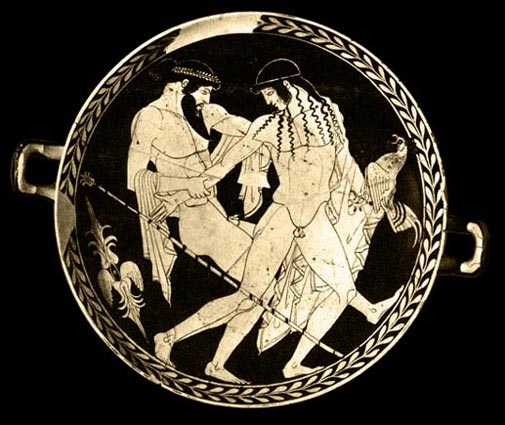
and this
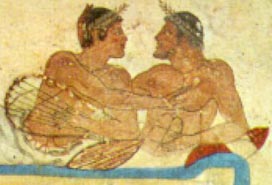
to this

From this

to this

And from this

to this

The message was clear.
What was once of the highest worth --
was now beneath worth.
The body had no connection with the holy or with the sacred.
It was sinful and unclean.
To be denied and denigrated.
Well, you get what you ask for.
Two thousand years later, we have communities of tens of thousands of gay-identified males living in the mutilated and negativised trash-heaps of the gay ghettoes who despise masculinity and who treat their bodies accordingly --
who treat their bodies like sewers.
Since 1975, as I said, those ghettoized communities have experienced epidemics of disease after disease after disease.
From syphilis to gonorrhea to herpes to HPV to intestinal parasites to hep B and C to HIV.
And now there are new diseases -- like LGV -- and MRSA.
Bigolpoofter, who was infected 23 years ago and has managed to survive, implored his fellows:
And, brothers, treat your bodies as temples, not sewers!
And oh how he was criticized and called out for doing it.
But he's right, and I echo his words:
Brothers, treat your bodies as temples, not sewers!
Now -- someone's bound to write to me and say -- Look Bill, you can get MRSA from Frot.
To which I say, Yeah dude.
You can get MRSA from sitting on a bench in your gym's locker room.
But guess what?
Based on that journal article, seems like you're more likely to get MRSA from that bench if your gym is predominately "gay."
Because the prevalence of MRSA is a lot higher among gay males than among non-gay people.
So: if you create a sewer and wallow around in it -- don't be surprised if you get sick.
What we need, clearly, is fewer sewers -- and more temples.
And that's something which is under *your* control.
That's why I've had this notice and this warning, posted in Frot Club, since the beginning:
Heroic Homosex does not endorse promiscuity.
If men into frot become as promiscuous as men into anal have been, frot will lose its innocence and joy and become yet another vector for STDs.
Don't let that happen.
That's also why I, and MANY OTHERS, have insisted from the beginning, that it's not enough to move men away from anal and towards Frot --
but that the entire analist paradigm has to be DESTROYED.
And replaced by a paradigm of Man2Man Love based on
Phallus
Fidelity
Masculinity
And which understands that Frot is a Holy Sacrament, Masculinity a Divine Principle, and Manhood a Divine Gift.
That's what must happen.
There's no way around it.
You cannot treat sexuality as unclean -- and expect it to remain healthy.
Won't happen.
Nor can you treat Manhood and Masculinity as a lower order of being -- and expect MEN to behave nobly and heroically.
That won't happen either.
We take the ideological, and spiritual, positions that we do -- because we understand the world -- as it is.
Not as some analist, feminist, femmy, trannie, secularist, or religious right fantasy --
but the World -- as it is.
In the World -- as it is -- the choice facing Men is stark.
It can be framed as secular:
|
FROT phallus fidelity masculinity LIFE |
anal anus promiscuity effeminacy death |
Or what it truly is, which is sacred:
|
SACRED FROT sacred phallus sacred fidelity sacred masculinity SACRED LIFE |
profane anal profane anus profane promiscuity profane effeminacy profane death |
That's the choice and it won't change, no matter how many obfuscations or evasions you make to yourself, to your friends, or to my inbox.
Temple or sewer?
The choice is yours.
It's ALWAYS been yours.
Bigolpoofter's exhortation was a true "cri du coeur" -- genuine and heartfelt.
For giving voice to it, he was shot down by his community -- not just of "gay" men, but of other HIV-affected people.
He was punished for saying what he believes.
Yet, he's right:
Bill Weintraub
January 23, 2008

© All material Copyright 2008 by Bill Weintraub. All rights reserved.

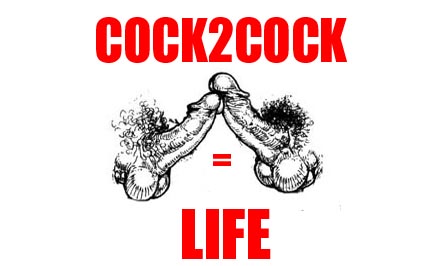
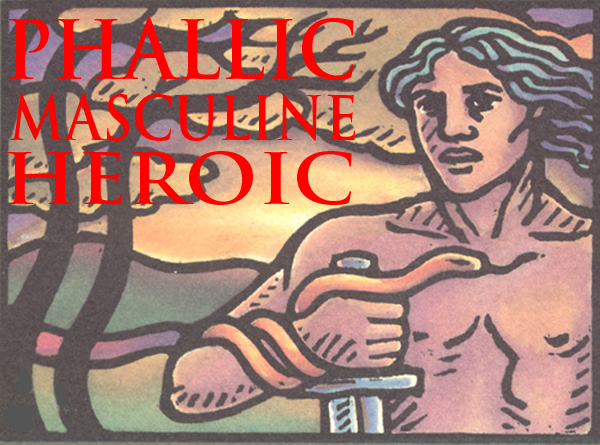



AND


Warriors Speak is presented by The Man2Man Alliance, an organization of men into Frot
To learn more about Frot, ck out What's Hot About Frot
Or visit our FAQs page.


© All material on this site Copyright 2001 - 2010 by Bill Weintraub. All rights reserved.


